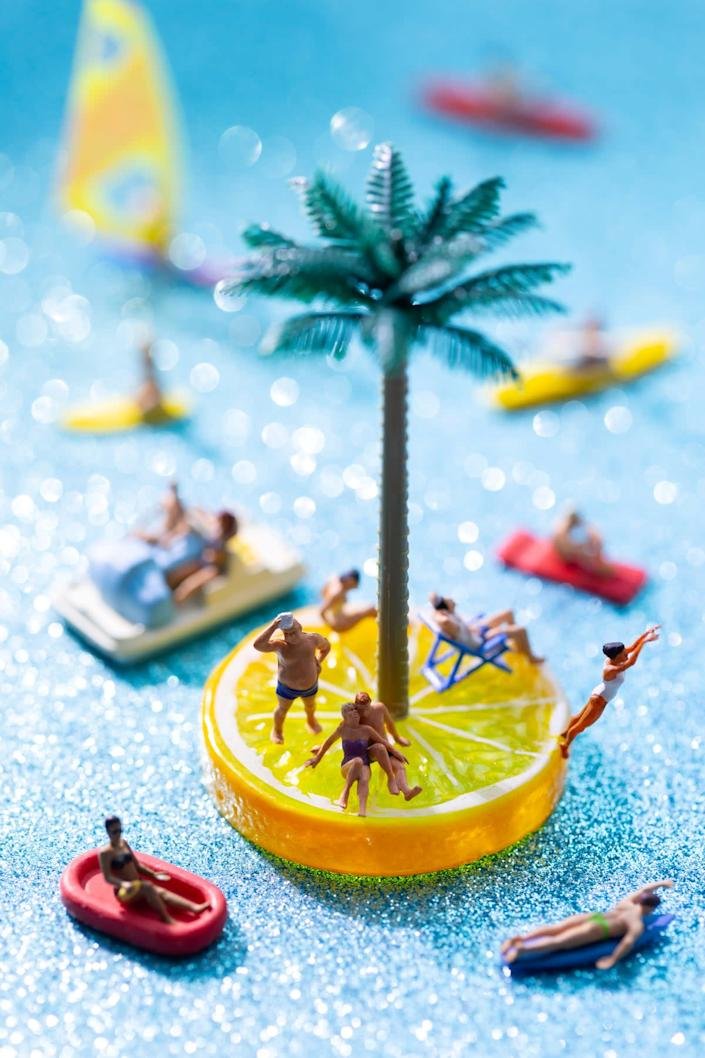Holiday dreaming: the ingenious creations of David Gilliver
Words by Meg Bulmer
A Holiday scene created by Gilliver
Art comes in so many different shapes, sizes, colours, styles (I could go on). Really, there is no limit to art or its potential in our world. During lockdown everyone sought solace and comfort where they could find it; no matter the source, a sense of relaxation and an escape from the uncertainty of reality was a need for many of us during the pandemic. One restriction that we faced during this time was an inability to travel; for those of us who had come to look forward to an annual sunny trip abroad in order to de-stress from day-to-day life, this was a significant constraint. As a result, many a dreary lockdown day could be whittled away dreaming of sandy beaches, fruity cocktails and a sunbed by the pool. One man in particular took this dream a step further.
Mount Melon
David Gilliver is a talented artist who studied at the Glasgow School of Art, and using miniature figurines and life-sized objects to create remarkable surrealist scenes has been a passion of his since before lockdown. The skillful and imaginative scenes created by Gilliver have caught the attention of many successful brands such as 3, Sony and Adobe, who have previously utilised his talents in their commercial campaigns. It is no wonder that the charming scenes have been appreciated for their worth in this way; Gilliver’s delightful use of regular objects, most notably fruit, staged amongst the lovingly painted figurines creates images of whimsy and appeal that captivate the viewer. In addition to the clever staging of the figurines, the impact of these pieces comes from their history; Gilliver collects the railway figurines himself from all over the world (some even from as far as Japan). Once he has collected the figurines, Gilliver sends them to be painted according to his specifications, before arranging them into darling miniature scenes. This aspect of his creations adds to their character; the care and consideration taken by Gilliver to find and collect each figurine adds a layer of love and affection to his artistic process, which injects additional feeling into his final images.
Hole in one
Unsurprisingly, when lockdown hit Gilliver tailored these surrealist creations to those subjects more relevant to viewers. He created the series 100 Dioramas in 100 Days between January and April of this year; the scenes in this series playfully depict tropical holidays, fun days out, and lots of wine-drinking. One of my favourite images from this series is Shorthenge (so dubbed by Gilliver himself), an image depicting people enjoying a day out at the sacred site of Stonehenge (created ingeniously by Gilliver with shortbread biscuits). The impressive imagination displayed by this image is a credit to Gilliver’s artistic talent, and his skillful use of light adds an additional dimension to the final captured image.
With each of his creations, as well as deciding how to most impactfully arrange the figurines alongside other objects, Gilliver must consider how light and shadow will interact with the pieces. This consideration adds further depth to the images; Gilliver’s skillful manipulation of light to create well-placed shadows within the scene further convinces the viewer that they are observing a real moment in the vivid lives of these figurines.
Shorthenge
Another of my favourite pieces from Gilliver’s lockdown collection is mask island, in which his little figurines sunbathe and relax on a tennis ball in the middle of a sea made of masks. The perspective created by Gillver in this photo is a testament to his skill; despite having undoubtedly taken the photo in a room like any other, through his placement of the objects and his use of the camera he has successfully created the illusion of a tennis ball island stranded and floating in an endless sea of masks. This is an example of how Gilliver’s photography and creation know no bounds; in this image we gain insight into the magic of his work, into his ability to create real worlds with the click of a camera and the placement of a handful of inanimate objects. I also like this image because Gilliver has taken an object with potentially stressful and negative connotations (masks), and turned them into a vast blue sea enjoyed by these little people on their holiday on a tropical island. To me this further underpins the value of his work and the work of artists in general; through art our perspective can be widened and challenged, and things once considered unpleasant can be made lighthearted and robbed of their power to create anxiety.
Mask Island
It is hard to pinpoint exactly why Gilliver’s creations spark such joy; each image provides fresh delight to the viewer. Especially during lockdown it is understandable that we would find escapism in these darling scenes, each created so meticulously and with such love by Gilliver that the complex and exciting lives of the figurines come alive in a vivid and delightful way. In this way the images ceased to be 3-dimensional inanimate stagings and instead became windows into the colourful life we all dreamed of returning to post-lockdown; whether it was playing a game of golf or lounging on an inflatable melon in the middle of the ocean, we saw ourselves in Gilliver’s little figurines. It is wonderful to consider the ways in which art brings joy to our lives; Gilliver’s particular style of creation is yet another of the unending examples of this. In collecting and caring for these figurines, and placing them with ingenious imagination and precise consideration into colourful uplifting scenes, Gilliver gave each one of us a window into vibrant moments full of life and adventure at a time when ours were so limited; he gave us a much needed escape and helped us hold on to our hopes for the future.





